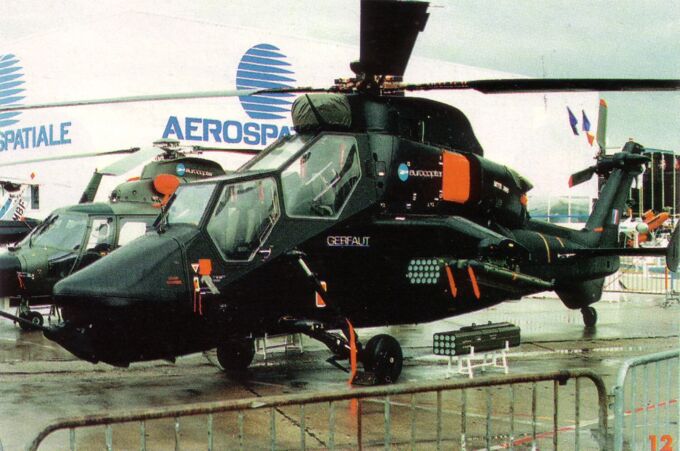The Eurocopter Tiger is commonly known as a German and French project that was also exported to Spain and Australia, but the story doesn’t end there. For a time in 1997, the Eurocopter Tiger was tested in Sweden, and the Swedish military even considered buying a number of them.
Introduction
The Eurocopter Tiger (in France and Spain, “Tigre”) was a joint German-French project to develop a next generation combat helicopter to replace the aging German BO 105s and French SA 340, 341, and 342 Gazelles. The project was initiated in 1984 and the group tasked with managing its development, Eurocopter Tiger GmbH, was formed on September 18, 1985. 5 prototypes were constructed for the helicopter (PT1-5), as well as 2 static airframes for fatigue and crash testing (PT6 and PT7), and PS1, a pre-production Tigre HAP.
All prototype and pre-production Eurocopter Tigers:
| Vehicle | Serial number | Role |
|---|---|---|
| Tigre PT1 | F-ZWWW | First aerodynamic prototype with basic avionics. |
| Tigre PT2 | F-ZWWY | Tigre HAP aerodynamic prototyope with full core avionics. |
| Tigre PT2R | F-ZWWY | Retrofit of the Tigre PT2 with additional Tigre HAP systems. Used for Mistral firing trials in 1998. |
| Tigre PT2R2 | F-ZWWY | Slight retrofit of the Tigre PT2R used for the Tigre HAP qualifications in 2000. |
| Tigre PT2X | F-ZWWY | Retrofit of the Tigre PT2R2 for use as a multimission demonstrator. A sighting system developed by LFK and SAGEM was installed for use with HOT-3 anti-tank guided missiles. |
| Tiger PT3 | F-ZWWT, redesignated as 9823 | Full core avionics configuration. |
| Tiger PT3R | 9823 | Retrofit of the Tiger PT3 with UH Tiger (a.k.a. UHT) systems. |
| Tigre PT4 | F-ZWWU | Full Tigre HAP aerodynamics and avionics configuration. Full history detailed in the rest of this article. |
| Tiger PT5 | 9825 | Full UH Tiger avionics systems. |
| Tiger PT5R | 9825 | Retrofit of the Tiger PT5 with production-standard weapons. |
| Tiger PT6 | N/A | Static test airframe for fatigue and crash resistance trials. |
| Tiger PT7 | N/A | Static test airframe for fatigue and crash resistance trials. |
| Tigre PS1 | F-ZVLJ | Prodution configuration Tigre HAP used to validate production methods and the planned production configuration. |
Tests in Sweden
Part of the requirements for the Eurocopter program was that it have the ability to operate in frigid climates. To complete those trials, Sweden agreed in 1996 to let the Eurocopter Tiger conduct tests in Sweden. Sweden agreed to this because they too were looking to replace the aging BO 105s, designated the hkp 9 in Swedish service, and the Eurocopter Tiger program’s need for cold weather testing matched up well with Sweden’s need for a new helicopter that could operate in its frigid climate.
Thus, in early January of 1997, a French Air Force C-160 Transall flew Eurocopter Tigre PT4, the first armed prototype of the Tiger bearing the serial F-ZWWU, to Kiruna Airport—the northernmost airport in Sweden. This not only delivered the Tigre PT4 to Sweden, but also acted as a successful test of the Tiger’s air transportability. Kiruna Airport, as well as at the Swedish Army’s Aviation Center in Boden, were where the Tigre PT4 was initially tested.
The tests involved flight performance and handling quality testing, further unloading and assembly from a transport, and operation in extremely low temperatures, which included ground resonance, cold soak start-up, and flame out trials. Weaponry testing was also performed and included firing of the 30 mm GIAT M781 cannon at -20ºC, firing of Mistral infrared-homing air-to-air missiles, evaluation of the Thales TopOwl helmet-mounted sight, of which the Tigre PT4 was a prototype, and tests of the night vision system.
The Eurocopter Tiger proved to perform so well in these conditions that it participated in the Swedish military exercise Polar Star, despite the tests not even being an official Swedish Army evaluation, let alone active service of any kind. When being tested in Sweden, the Tigre PT4 supposedly had a white moose painted on it, but images of this cannot be found and very possibly do not exist.
There is only one known publically available image of the Eurocopter Tigre PT4 in Sweden, but due to copyright, it cannot be shown in this article. The image can be found in the 1997 book Arméflygets historia by Per-Anders Lundström.
After Sweden
After 6 weeks of testing, the Tigre PT4 completed its cold weather evaluation on February 13, 1997, and was subsequently flown back to France. These tests resulted in Sweden being interested in potentially purchasing 24 of the helicopters. This never occurred, not because the Eurocopter lost to any other vehicle, but rather because budget cuts quashed the endeavor altogether. It is unlikely that this was ever a proper procurement program. Rather, it is more likely that it was a consideration that never progressed.
The Tigre PT4 flew for a total of 296 hours before being destroyed in a crash during a low altitude, nighttime evaluation flight near Townsville in Queensland, Australia on February 17, 1998. That nighttime evaluation was part of a bid to sell the Eurocopter Tiger to Australia. Due to the crashworthy design of the Eurocopter Tiger, both pilots survived and were uninjured. Despite the crash, this bid later succeeded as the Tiger ARH.
Sources
- Eurocopter “Tiger” 1997. (2024).
- Eurocopter Tiger Completes Arctic Testing in Sweden. (1997). Helicopter News.
- Lundström, P.-A. (1997). Arméflygets historia. Svenskt militärhistoriskt bibliotek.
- Moxon, J. (1997). Tiger begins to roar. FlightGlobal.
- TopOwl, Helmet-mounted Sight & Display for Helicopters. (n.d.). Thales.
This article was written with great assistance, especially with sourcing, from NoahHuls.



